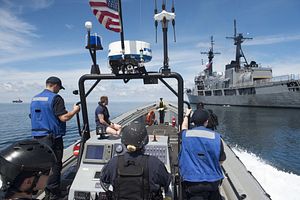Last week, the United States and the Philippines carried out the latest iteration of a new maritime training activity between the two sides that has taken place under Philippine President Rodrigo Duterte. The interaction highlights the continuing cooperation between the two longtime treaty allies despite the challenges the relationship has faced thus far under Duterte.
As I have been noting in these pages, Duterte’s emergence has seen a mix of continuity and change in U.S.-Philippine defense relations, including with respect to individual projects and exercises both countries hold (See: “Why the New US-Philippines Military Pact’s First Project Launch Matters”). An example is the fact that while the Philippines was initially out of the Cooperation Afloat Readiness and Training (CARAT) exercise series that the United States carries out with a number of Southeast Asian states, both sides had set up a new training activity codenamed Sama-Sama to focus on a similar list of common security concerns.
The first iteration of Sama-Sama occurred last June, and the focus was on the same sorts of engagements both sides had carried out previously, with a similar level of participation from U.S. assets as well. Following Sama-Sama, the two countries also conducted a coordinated patrol in the Sulu Sea, which has become an area of ongoing maritime security cooperation involving regional as well as extraregional states to varying degrees.
From July 9 to July 14, the U.S. and Philippine navies held another iteration of Sama-Sama. According to the U.S. Navy, the engagement focused on a full spectrum of naval capabilities, with engagements covering areas such as air defense, dividing, and search and rescue at sea along with shore phase symposiums and seminars including capabilities such as explosive ordnance disposal and anti-submarine and surface operations.
Interestingly, while last year’s focus was more on the Sulu Sea relatively speaking, this year saw a focus on the South China Sea. U.S. and Philippine vessels – on the U.S. side the USNS Millinocket, dividing and salvage ship USNS Salvor, and a P-8 Poseidon maritime surveillance aircraft, and on the Philippine side, Philippine navy frigate BRP Ramon Alcaraz and landing dock ship BRP Tarlac – conducted activities in the South China Sea. Notably, the timing of the engagement came during the commemoration of the second anniversary of the July 12 arbitral ruling on the Philippines’ South China Sea case against China (See: “Beware the Illusions of China-Philippines South China Sea Breakthroughs”).
Another notable development was the integration of Japan into the exercise, with the Japan Maritime Self-Defense Force (JMSDF) joining the exercise as an observer. Beyond the development itself, this reinforces a broader trend where Japan has been included in several U.S.-Philippine bilateral engagements, including the annual Balikatan exercises, as Tokyo itself expands its security collaboration with Southeast Asian states. Apart from the engagement itself, both U.S. and Japanese officials also met with Philippine Navy officials during their visits there.
To be sure, the U.S.-Philippine alliance, and the defense cooperation therein, ought to be evaluated comprehensively rather than from the perspective of a single exercise. But as U.S.-Philippine interactions develop on through the rest of the year and into 2019, engagements like Sama-Sama will continue to be ones that will be worth keeping an eye on for how ongoing collaboration is evolving.

































